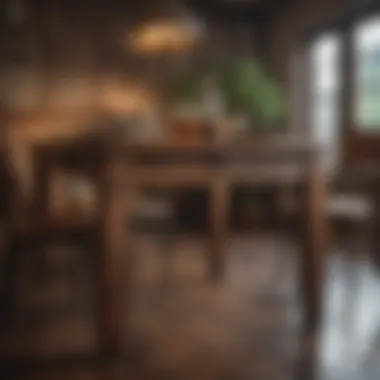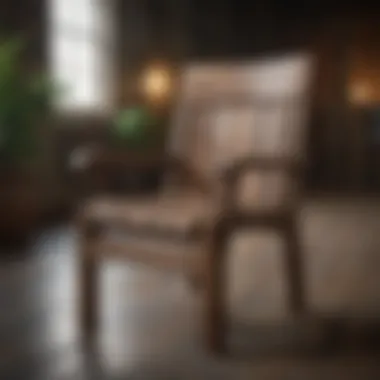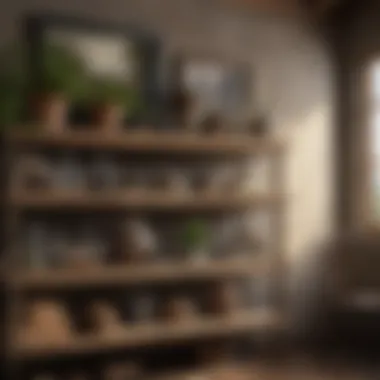A Visual Journey through Rustic Furniture Design


Intro
Rustic furniture captures a timeless charm, often characterized by its use of natural materials and minimalist aesthetics. This design style resonates with many homeowners and interior design enthusiasts seeking to create spaces that feel grounded and inviting. Understanding not only the visual aspects of rustic furniture but also its thematic relevance in various settings is essential for anyone looking to enhance their interior with genuine rustic elements.
In this article, we will dive into several key aspects of rustic furniture, including design inspiration, current trends, practical applications, and maintenance tips. Through this exploration, we aim to equip readers with a well-rounded perspective on rustic furniture's role in modern design, ultimately inspiring all to incorporate these unique pieces into their homes.
Understanding Rustic Furniture
Understanding rustic furniture is essential for anyone looking to incorporate this distinctive style into their home. Rustic furniture often resonates with a sense of warmth and authenticity, bridging the gap between nature and domestic life. The aesthetic appeals to homeowners, interior design enthusiasts, and gardening aficionados alike, all of whom seek to create spaces that feel grounded and connected to the natural world.
Defining Rustic Style
Rustic style is not easily confined to a strict definition. It draws inspiration from simplicity and the rugged beauty of nature. Often, rustic furniture is made from solid wood, showcasing natural textures and imperfections. This approach emphasizes a handcrafted feel, often derived from traditional joinery techniques. The goal is to highlight the inherent qualities of the materials used, creating pieces that tell a story rather than conforming to modern industrial standards.
Historical Context of Rustic Furniture
The history of rustic furniture can be traced back to various cultures that prioritized functionality and durability. In rural communities, pieces were often created from available materials, reflecting the resourceful nature of those who crafted them. For example, early American settlers used local woods to create simple but sturdy furniture that suited their needs. Over the years, rustic design has evolved, yet it remains a testament to craftsmanship and the artistic representation of everyday life. The enduring popularity of this style speaks to its timeless relevance in modern interior design.
Characteristics of Rustic Furniture
Several key characteristics define rustic furniture:
- Natural Materials: Predominantly wood, often left unfinished or lightly treated.
- Organic Shapes: Pieces frequently feature organic forms and rough edges, emphasizing craftsmanship.
- Earthy Colors: A palette inspired by nature, incorporating browns, greens, and muted tones.
- Functional Design: Emphasis on usability and practicality in each piece.
Rustic furniture captures the essence of a home that values comfort and intimacy. By understanding these characteristics, individuals can better appreciate the role that rustic pieces may play in enriching their living spaces.
Materials Used in Rustic Furniture
Exploring the materials used in rustic furniture is essential to understanding its appeal and function. The choice of materials contributes to the overall aesthetic and durability of pieces. Rustic furniture often evokes a sense of warmth and comfort, qualities that are largely influenced by the materials selected. Commonly, natural materials enhance the rustic charm, while considering environmental aspects and craftsmanship reveals the depth of this design style.
Wood Types Common in Rustic Design
Wood is the cornerstone of rustic furniture. Different types of wood are utilized, each contributing unique characteristics. Common choices include oak, pine, cedar, and reclaimed wood. Oak is favored for its strength and distinct grain. Pine, being lighter, exudes a more casual vibe, while cedar is appreciated for its natural resistance to decay and pleasing scent. Reclaimed wood, sourced from old barns or factories, not only showcases history but also supports sustainable practices.
When gathering pictures of rustic furniture, pay attention to the wood grains, colors, and finishes. Look for imperfections and variations; these elements highlight the uniqueness of each piece.
Environmental Considerations in Material Selection
Choosing materials wisely is becoming increasingly significant. Environmental considerations influence both consumer choices and production practices. By opting for sustainably sourced wood, buyers can support responsible forestry efforts. Certifying organizations like the Forest Stewardship Council provide guidelines that reflect environmental integrity.
Furthermore, utilizing reclaimed or recycled materials reduces waste. These choices are essential not only for aesthetic design but also for ecological responsibility. This awareness significantly elevates the value of rustic furniture in any setting.
Craftsmanship and Handcrafted Elements
Finally, the craftsmanship involved in rustic furniture cannot be understated. Handcrafted pieces reflect unique artistry and an attention to detail that mass-produced items lack. Often, artisans use traditional techniques that have been passed down through generations.
The appeal of rustic furniture lies in its imperfections. Dents, knots, and variations in texture add authenticity to pieces. These characteristics tell a story—making each item not just furniture, but part of a larger narrative.
> "Rustic furniture is a testament to craftsmanship, providing both function and an artistic expression that resonates with the soul."


In retrospect, the materials selected for rustic furniture go far beyond mere aesthetics; they involve environmental impact and craftsmanship that enhance the overall charm and culture of design.
Integrating Rustic Furniture into Your Space
Integrating rustic furniture into your space is a vital topic that bridges aesthetics and functionality. The rustic style, known for its connection to nature and simplicity, can transform any room into a cozy and inviting area. Its charm lies in the natural materials and textures, which bring a sense of warmth. This blend not only enhances the overall decor but also elevates the ambiance. As you consider this integration, think about how rustic pieces complement your existing design. Room by room, rustic furniture can blend seamlessly with different styles. Here are specific elements and benefits to keep in mind.
- Versatile Styles: Rustic furniture can work with various design themes, from modern to traditional. This versatility allows homeowners to mix different styles creatively.
- Warmth and Comfort: The natural look of rustic furniture invites warmth. Whether it's a rustic coffee table or a handmade rocking chair, these pieces often feel inviting to sit and relax.
- Eco-Friendly Choices: Often made of reclaimed wood or sustainably sourced materials, rustic furniture supports eco-friendly practices. Integrating such pieces into your home reflects responsible consumption.
"Rustic furniture is not just about style; it embodies a lifestyle choice toward simplicity and natural beauty."
Living Room Ideas with Rustic Furniture
The living room is a central space in a home. Here, rustic furniture can be particularly effective. Ideas for incorporating rustic elements include:
- Wooden Coffee Tables: A sturdy, handmade coffee table can serve as a focal point. Look for pieces with visible grains or unique knots in the wood.
- Textured Sofas: Fabrics like burlap or denim often work well with rustic furniture. Consider adding a couch that features these textures to enhance comfort and aesthetics.
- Accents with Nature: Add decorations like potted plants or natural materials. This practice emphasizes the rustic theme and brings life into the room.
Rustic Dining Room Inspirations
The dining room benefits immensely from rustic furniture's charm. It promotes gatherings and can create a warm atmosphere for meals. When designing your rustic dining area, consider:
- Long Wooden Dining Tables: Nothing speaks rustic like a long table crafted from reclaimed wood. It provides ample space and sets the stage for family dinners or gatherings.
- Mismatched Chairs: A mix of wooden chairs can add character. Each chair can tell a story, enhancing the rustic vibe.
- Natural Lighting: If possible, position your dining space to maximize natural light. Combine this with wooden fixtures for a harmonious dining experience.
Creating a Rustic Bedroom Ambiance
The bedroom should be as inviting as it is restful. Rustic furniture can create an atmosphere perfect for relaxation. Here are some strategies:
- Bed Frames with Character: A wooden bed frame is essential. Look for options that showcase original wood textures or aged finishes for authenticity.
- Layering Textiles: Incorporate quilts and throw blankets made of organic materials. They not only keep you warm but also enhance the cozy feel.
- Warm Lighting: Select lamps or sconces that emphasize a rustic aesthetic. Fluted glass or wrought iron finishes can amplify the charm.
By strategically incorporating rustic furniture, you can enrich your living space. Each area of the home tells its own story, and rustic pieces contribute greatly to that narrative. Consider how these elements can harmonize with your style and needs to create an enriched living environment.
The Aesthetic Appeal of Rustic Furniture
The aesthetic appeal of rustic furniture is not merely about its placement in a room or its visual characteristics; it embodies a philosophy of design that resonates with both warmth and authenticity. This section explores how rustic furniture contributes significantly to the overall ambiance of a space through its unique design elements. Understanding and appreciating these elements can help homeowners and interior design enthusiasts create inviting environments that reflect personal style.
The Role of Texture and Color
Texture and color are vital components of rustic furniture, shaping not just the physical appearance but also the emotional impact of furnishings. Textures in rustic design often incorporate natural materials, such as rough-hewn wood, woven fabrics, and metal accents. These surfaces invite touch and offer a tangible quality that stark modern designs lack. Items like reclaimed barn wood tables or hand-forged iron accents can serve as focal points in a room.
Color palettes in rustic furniture typically draw from nature, featuring earthy tones like browns, greens, and warm reds. Such colors not only enhance the natural aesthetics but also foster a sense of calm. The palette's warmth ensures that a space feels relaxing and lived-in, encouraging connection among those who occupy it.
Combining diverse textures with complementary colors helps create depth within an interior. As you explore different pieces, consider how their textures and hues will coordinate with your overall décor and the message you wish to convey in your home.
Fostering a Warm Environment
One of the essential benefits of rustic furniture is its inherent ability to foster a warm environment. Pieces crafted from natural materials often give off a sense of comfort and coziness that stark, contemporary furniture struggles to achieve. When combined effectively in any interior design, rustic elements create spaces that feel more inviting.
Rustic furniture embodies an inviting aesthetic that supports interaction among guests. Items like a large farmhouse table can become the centerpiece of gatherings and encourage conversation. Similarly, plush upholstery on rustic seating promotes relaxation, allowing individuals to settle in comfortably.
"The warmth of rustic design lies in its ability to make a house feel like a home."


To cultivate a warm atmosphere, mix rustic furniture with light fixtures that provide soft illumination, wall textures that invite touch, and color choices that evoke serenity. When integrated thoughtfully, rustic furnishings create a balanced and harmonious atmosphere.
Sourcing Rustic Furniture
Sourcing rustic furniture is a critical step for anyone looking to enhance their living space with unique and authentic pieces. The process involves both the search for items and understanding the value these pieces hold. Rustic furniture is often distinguished by its handmade quality, natural materials, and artful imperfections. When seeking to incorporate rustic elements into your home, it is important to consider the sources from which these items come. Local artisans, online marketplaces, and vintage shops all play significant roles in this pursuit.
Local Artisans and Their Impact
Local artisans have the ability to create one-of-a-kind rustic pieces. They often use traditional techniques and local materials, resulting in furniture that reflects the culture and environment of the area. Supporting artisanal production not only helps sustain local economies but also promotes craftsmanship that may be lost in mass production.
When buying from local artisans, it is essential to evaluate their work. This can include examining the quality of construction and design. Many artisans offer customizations, allowing buyers to create pieces tailored to their specific needs or tastes. This personal touch can elevate the aesthetic of your space and ensure that your rustic pieces hold sentimental value.
Online Marketplaces for Rustic Furniture
The advent of online marketplaces has revolutionized the way people acquire rustic furniture. Websites like Etsy, eBay, or specific furniture sites have a diverse range of options, from vintage to modern rustic designs. Shoppers are no longer limited to local options and can browse collections from artisans around the world.
When using online platforms, it is important to read reviews and check seller ratings. High-quality images can help you assess the piece more accurately. Moreover, be cautious about shipping costs and item descriptions. Some items may appear rustic but be made from synthetic materials, diluting the charm of the style.
Antique Shops and Vintage Finds
Antique shops and flea markets are treasure troves for rustic furniture seekers. The appeal of these venues is their eclectic inventory. Every visit can lead to unexpected discoveries, from reclaimed wood tables to wrought iron chairs. A vintage find carries history and character that new furniture often lacks.
When shopping at antique shops, it is beneficial to have a discerning eye. Look for pieces that may need minor restoration, as these can often be acquired for a lower price. A little effort in restoration can make a piece truly unique. Knowledgeable store owners can also provide insights into the origins of items, which can enhance their story and value in your home.
"The beauty of rustic furniture lies not just in its appearance, but in the stories and craftsmanship behind each piece."
By strategically utilizing these sources—local artisans, online platforms, and vintage stores—you can curate a collection of rustic furniture that reflects your personal taste while contributing positively to the environment and local artisans.
Maintaining Rustic Furniture
Maintaining rustic furniture is crucial for both aesthetics and longevity. This style often utilizes natural materials and craftsmanship, which can be susceptible to various forms of wear and tear. Without proper care, the beauty and functionality of these pieces may diminish over time. By prioritizing maintenance, owners not only preserve their investment but also enhance the overall ambiance of their spaces. The careful upkeep of rustic pieces complements their unique character and helps retain their charm in the long run.
Cleaning Methods for Rustic Pieces
Cleaning rustic furniture requires a gentler approach compared to more modern finishes. Here are effective methods to maintain its beauty:
- Damp Cloth: Use a soft, damp cloth for regular dusting. This prevents dust accumulation without scratching the surface.
- Mild Soap: For stains, a mixture of mild soap and water can be used. Test it first on an inconspicuous area to ensure compatibility.
- Furniture Polish: A natural wood polish can enhance the finish and provide necessary moisture. Look for products that contain no harsh chemicals.
- Avoid Water Saturation: Be careful not to soak the furniture. Excess water can warp or damage the wood over time.
These cleaning methods ensure rustic furniture remains inviting and functional. Proper cleaning removes dirt while preserving the finish's integrity.
Preventing Wear and Tear
To extend the life of rustic furniture, preventing wear and tear is vital. Here are several key considerations:
- Placement Considerations: Avoid placing rustic furniture in direct sunlight. This prevents fading and drying of the wood.
- Temperature and Humidity: Maintain stable indoor humidity. Extreme fluctuations can cause wood to crack or warp.
- Use Coasters and Mats: Protect surfaces from spills and scratches by using coasters under drinks or mats under decorative items.
- Regular Inspections: Check for any signs of damage regularly. Addressing small issues early can prevent more significant problems later.
The combination of regular cleaning and preventative measures creates a robust strategy for maintaining the integrity of rustic furniture.
With these insights, homeowners can appreciate their rustic furniture not only for its aesthetics but also for its durability. This attention to maintenance enriches the home's overall charm and functional beauty.


Customization and Upcycling
Customization and upcycling play a vital role in the realm of rustic furniture. These practices not only enhance the aesthetic appeal of your space but also provide an opportunity to express individuality and creativity. By tailoring furnishings to meet personal needs and preferences, homeowners can ensure that each piece resonates with their unique style. Additionally, upcycling contributes to sustainability by giving new life to old furniture, thus minimizing waste and preserving resources. The importance of understanding both elements cannot be overstated, as they allow for practical yet artistic interventions in home decor.
Personalizing Your Rustic Furniture
When it comes to personalizing your rustic furniture, there are many avenues to explore. Here are some ideas to help you create a space that feels authentically yours:
- Choose Paint or Stain: Applying a new color or stain can drastically change the appearance of a piece. Consider using natural finishes that complement the rustic aesthetic.
- Add Hardware Accents: Unique handles or knobs can transform cabinets and drawers. Search for vintage or artisanal options to add character.
- Incorporate Textiles: Custom cushions or covers can infuse warmth and softness into hard furniture. Opt for fabrics that reflect natural tones or patterns inspired by nature.
- Integrate Natural Elements: Incorporating elements such as stones, branches, or reclaimed wood can emphasize the rustic feel while adding your personal touch.
Each of these methods allows for a degree of personalization that can make your furniture both functional and an expression of your identity.
Innovative Upcycling Ideas
Upcycling is a creative way to repurpose old furniture, giving it a new lease on life. Here are some innovative ideas for upcycling rustic pieces:
- Transforming Pallets: Wooden pallets can be turned into coffee tables, planters, or even bed frames. A bit of sanding and finishing can elevate their look.
- Creating Wall Art: Old chairs or tables can be mounted on walls to serve as unique shelving units or decoration, adding dimension to your space.
- Mixing Materials: Combining different materials, such as metal and wood, can yield striking results. Consider fabricating new tables that incorporate glass tops with reclaimed wood bases.
- Reinvention of Old Dressers: An old dresser can be stripped down and converted into a trendy kitchen island or a chic bathroom vanity.
Engaging in these upcycling projects not only serves practical needs but also speaks to an ethos of sustainability.
"In the world of rustic furniture, customization and upcycling manifest not only creativity but also the potential for meaningful environmental impact."
These initiatives not only breathe new life into existing pieces but also ensure that your home remains a reflection of your values and design sensibilities.
Rustic Furniture Trends
Understanding current trends in rustic furniture is critical for anyone looking to incorporate this style into their spaces. Trends evolve over time, and recognizing what resonates with today's aesthetics can ensure that your rustic furniture choices are both modern and timeless. Keeping abreast of trends in rustic design not only enhances your home but also reflects your personality and taste within your environment.
Current Trends in Rustic Design
In recent years, rustic design has seen a revival that is both contemporary and nostalgic. Several key trends stand out, shaping how rustic furniture is perceived and utilized today:
- Mixed Materials: The shift toward combining materials such as wood, stone, and metal is prevalent. This juxtaposition creates depth and interest, making furniture pieces versatile for any setting.
- Minimalism Meets Rustic: A minimalist approach has emerged, emphasizing simplicity while retaining the warmth of rustic design. Clean lines and uncluttered spaces with a few carefully chosen rustic elements provide balance.
- Sustainable Practices: The focus on sustainability is profound in current trends. Homeowners are increasingly interested in eco-friendly materials, ensuring the wood is ethically sourced and reclaimed where possible.
- Bold Colors and Finishes: While traditional rustic design often features subdued tones, modern interpretations include bolder color palettes. Brightly stained woods and painted finishes are gaining popularity, introducing a fresh take on rustic aesthetics.
- Functional yet Artistic Pieces: The trend leans towards multifunctional furniture that carries an artistic flair. Items that serve practical purposes while also acting as conversation starters are highly sought after.
These trends highlight an evolving understanding of rustic design, blending its heritage with contemporary needs.
Future Directions for Rustic Aesthetics
Looking forward, the future of rustic furniture trends appears promising and dynamic. Several anticipated directions will likely define rustic aesthetics in the coming years:
- Integration of Technology: As smart home devices become standard, rustic furniture designers may incorporate technology seamlessly. Expect to see pieces with built-in charging stations or adaptive furniture that serves multiple smart home functions.
- Global Influences: As cultures intertwine, rustic designs will likely reflect international inspirations. This could include elements from Scandinavian simplicity, Mediterranean warmth, or Japanese minimalism, enriching the traditional rustic framework.
- Biophilic Design: With a growing emphasis on connection to nature, future trends in rustic design will probably incorporate biophilic elements. Furniture that enhances natural light and connects spaces with the outdoors will become increasingly popular.
- Personalization: Customization will take center stage. Homeowners may seek unique pieces that tell their story, whether through crafting methods or personalized finishes.
- Revival of Handcrafted Elements: There is a resurgence of interest in handcrafted furniture. This shift not only supports artisans but often results in one-of-a-kind pieces that carry a story and authenticity.
Recognizing these future trends provides an insight into how rustic furniture will adapt while retaining its charm. The fusion of traditional craftsmanship with modern sensibilities can create a seamless blend of style and function.
Epilogue: The Lasting Impact of Rustic Furniture
Rustic furniture embodies more than just a stylistic choice; it represents a connection to nature, tradition, and craftsmanship. Understanding the lasting impact of rustic furniture enables homeowners and enthusiasts alike to appreciate not just its aesthetic qualities, but its role in creating inviting environments.
A significant aspect of rustic furniture is its ability to foster warmth in living spaces. The natural materials, often characterized by organic textures and earthy tones, contribute to a cozy atmosphere. This warmth appeals particularly to those seeking comfort in their home designs, making rustic pieces invaluable for creating relaxing retreats.
"Rustic furniture is a reminder that beauty often lies in the raw and unrefined."
Moreover, rustic furniture encourages sustainable practices. Many pieces are made from reclaimed or responsibly sourced materials. This consideration not only helps the environment, but also supports craftsmanship within local communities. By selecting such items, individuals contribute to a cycle of sustainability, which aligns perfectly with modern consumer values.
Another benefit is versatility. Rustic furniture can blend seamlessly into various interior design themes, from modern to traditional. The organic forms and rugged finishes of rustic pieces add an element of character to sterile spaces, offering contrasts that make interiors more visually appealing. This adaptability makes rustic designs increasingly relevant in contemporary homes.
Homeowners need to consider the emotional resonance of rustic furniture as well. Each piece often tells a story. Be it a weathered oak table that has hosted family gatherings or a hand-carved chair that reflects the skill of its maker, these stories contribute to the unique charm that rustic furniture brings. This connection enhances the meaning of the items and fosters a deeper appreciation for the space they inhabit.



